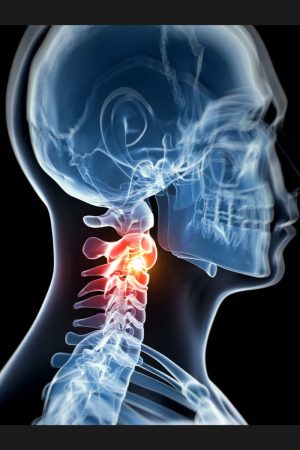Discogenic neck pain is a type of pain that arises from a problem within one of the discs in the neck. The discs in the neck are located between the vertebrae, and they act as shock absorbers to protect and support the vertebrae during movements such as bending and twisting. When a disc becomes damaged or inflamed, it can cause pain in the neck.
There are several potential causes of discogenic neck pain, including degenerative changes in the disc, injury to the disc, and improper movement patterns that put excess strain on the discs. Symptoms of discogenic neck pain may include pain in the neck that is worse with certain movements, stiffness in the neck, and difficulty turning the head.
Treatment for discogenic neck pain often begins with conservative approaches such as rest, ice or heat therapy, and physiotherapy. Physiotherapy can help to stretch and strengthen the muscles in the neck, improving movement and reducing pain. In addition, a physiotherapist may recommend certain exercises to help improve posture and reduce strain on the discs in the neck.
If conservative treatment methods are not effective, other options such as medication or injections may be considered. In severe cases, surgery may be necessary to repair or replace damaged discs.
We recommend applying the 5 stages of rehab to discogenic neck pain.
- Pain – Inflammation often plays a significant role in pain and discomfort associated with discogenic neck pain. Early management focuses on offloading and reducing inflammation with activity modification, postural correction, anti-inflammatory medications, hot/cold therapy, and gentle joint mobilization. Physiotherapy treatments in the first 2 weeks will typically result in significant reduction of symptoms and improved function.
- Range of motion – Scar tissue, protective muscle spasm/tightness and joint stiffness can all limit neck and joint range of motion. Initial range of motion improvements, associated with reduction of acute inflammation, can be quite significant and occur relatively quickly. Changes associated with altering tissue mobility or length occur more gradually over a couple of months.
- Motor Control – Regaining adequate motor control is vital to prevent future exacerbations of the condition and settle chronic inflammation. Discogenic neck pain commonly occurs when excessive load is placed on a disc. Good control of neck movement will allow the load to be evenly distributed across multiple discs, joints and neck tissues.
- Strength – Strength training after obtaining full range and motor control builds resilience and allows return to high demand activities and tasks. Strength training might include resisted chin tucks or controlled head movements, training against gravity in a chest lift, plank or side plank position or upper limb strengthening exercises.
- Maintain – It is important to maintain range of motion, motor control and strength gains. It is typically easier to maintain a particular state than make positive gains or changes. Exercise and treatment frequency can be gradually reduced but it is important not to cease rehabilitation exercises completely. An important consideration is that most disc overload occurs when one disc is over burdened due to stiffness, loss of control or loss of strength in the adjacent tissues.
At Range Physio, we believe in treating the underlying cause of neck pain, rather than just focusing on symptom relief. If you are experiencing discogenic neck pain, we encourage you to schedule an appointment with one of our physiotherapists. We are here to help you actively enjoy life.


